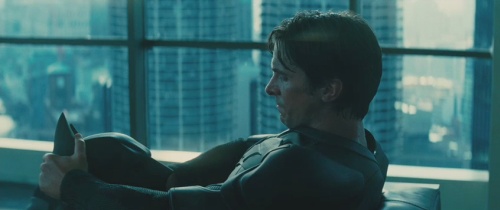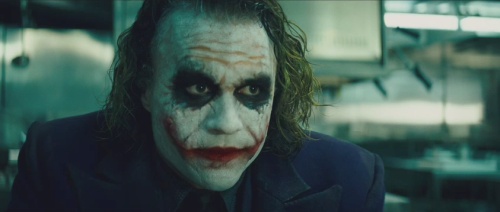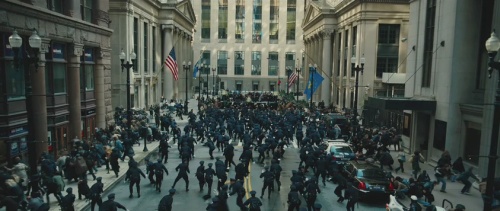The Dark Knight (Christopher Nolan, 2008)
I was not one of those who flipped for Christopher Nolan’s Batman Begins: as I said in a brief write-up at the time, I thought it was poorly shot and thematically muddled. But the more serious problem was just that it was too not fun. That, of course, was supposed to be the point: Nolan was taking us back to a dark version of the Batman character after the more comic bookish 80s and 90s movie version (although I can remember when Burton’s 1989 take was considered the return to a dark take on the character). However, while I applaud the concept of taking a genre project seriously, part of doing a serious superhero film is that you have to make the superhero side of the equation work also. In Batman Begins, Nolan and his co-screenwriter David S. Goyer dropped that ball through their determination to make Batman plausible as something other than a genre conceit. There was a feeling that they were ticking off explanations for things the audiences would have taken for granted: look – it kind of makes sense that he has all these gadgets, because the Wayne foundation has this big R&D branch! Look – here’s an explanation of how he can use his cape to fly! Look – here he is putting together his damn suit! We didn’t need to see that stuff, and by seeming simultaneously apologetic about Batman’s ridiculousness, while at the same time trying to make the most earnest Batman movie ever, I think Nolan came across as a little foolish. A Batman film can explore serious themes, sure, but at the end of the day it is still, as Jaime Weinman put it, about “a rich kid with no powers who decides to avenge his parents by fighting crime in a bat suit.” The best way to sell that kind of idea is to relax and have fun with it, and on that score I don’t think Batman Begins worked very well at all.
By now you have probably heard that Nolan’s sequel The Dark Knight is the ultimate descent into hell for Batman, and you are probably thinking that I would feel it suffered the same problem. It is after all, a very grim film indeed, in which Heath Ledger’s psychotic Joker wreaks widespread havoc and inflicts real and lasting harm to several major characters. Yet, oddly, despite all the carnage that unfolds, The Dark Knight is much more fun than its predecessor. And it’s the nifty trick of making such a dark film so enjoyable that makes it something really worthwhile.
The Joker is key to this. Again, you’ve probably read all the other reviews in which critics reach for their thesauruses for superlatives to describe Heath Ledger’s performance in the role. I won’t try to get into that, but yes, he really is that good. Ledger isn’t afraid to overplay it, mixing big look-at-me flourishes (the voice, the giggles) with creepy little details (the flicking tongue, the smarmy way he rolls his words). The overall effect is compelling. Crucially though, given my opening comments, he’s always entertaining to watch: the Joker is scary as hell, but it’s fun-scary. I’ve seen a few reviews that note Batman recedes from the foreground as a result of the prominence given to the Joker and to other characters. That’s sort of true, in that the film isn’t really the Batman vs. Joker showdown it at times tries to spruik itself as: ultimately, the fight against the Joker becomes a team effort involving Batman, Gary Oldman’s good policeman Jim Gordon, and Aaron Eckhart’s charismatic district attorney Harvey Dent. What is really entertaining about this is the way it expands the film’s focus to a very grand, city wide canvas: it’s the sheer sweep of the film that, along with the Joker, makes it so much better than Batman Begins.
This wider scope means The Dark Knight is much more of a portrait of Gotham City and its various strata of citizens than the earlier film, and it’s interesting how much it actually reconfigures the depiction of Gotham despite otherwise tight continuity between the two films. Batman Begins’ Gotham was a largely computer generated fantasy metropolis, but The Dark Knight’s Gotham is clearly a real city (it was mostly shot in Chicago). This grounds and de-clutters the film, and the film’s starkness is established by character and plot rather than rammed down your throat through production design. In a way, it’s as if superhero films have come full circle. Remember how Richard Donner’s Superman made no real attempt to pretend Metropolis was anything other than the real New York? Tim Burton’s Batman put such simple location work out of favour, establishing a trend where any really big superhero blockbuster was expected to create an elaborate fantasy city: you saw that in the 90s Batman sequels, and also other films such as Dick Tracy. Sam Raimi led the charge away from that approach with his Spider-man films, and now Nolan seems to have decided it was safe to give up on the fantasy city for the Batman franchise too. It’s a big part of why this feels like just a particularly epic crime drama, rather than a superhero film per se.
The realism of Nolan’s city is enhanced by Nolan’s use of Imax cameras for parts of the film. I haven’t seen too many reviews comment on this aspect of the film (perhaps because critics’ screenings weren’t in the format) but it’s one of the more interesting things about the film. Other Hollywood films to play at Imax have just blown up regular 35mm features onto the giant screen (sometimes with some 3-D incorporated), but The Dark Knight is a true multi-format production, with significant stretches shot using the large format cameras. Watching the Imax version, it seemed clear Nolan intended it to be the format of preference: the Imax sequences always looked carefully composed, rather than being an open-matte afterthought. In its truest exhibited form, then, this is a multi-aspect ratio film, switching to a taller and squarer frame not just for big action sequences, but also for individual shots dotted liberally through the film. I have reservations about Imax as a general release format: there are few Imax cinemas about, so many people will miss out; those Imax theatres that do exist usually contain far too many seats in terrible positions; and a hybrid aspect-ratio film can never be viewed properly on home formats (viewed on a widescreen television the viewing area screen would need to get smaller for the Imax sequences, since the frame is squarer). However, it must be said that seen on Imax, the film looked terrific. There is a wonderful shot of Batman gliding over the city that, finally, realises the visual potential of Batman actually flying: in previous films he always seemed to drop vertically between buildings like a black-suited sack of potatoes. I wonder, too, if the bulkier Imax cameras weren’t partially responsible for stilling Nolan’s hand in the action sequences: his choreography of the action remains confusing at times, but the actual shots themselves are much steadier and more composed.
Being better shot than its predecessor, with a more appealing setting and villain, the film sweeps you past its negatives much more quickly. There are still issues, though. These include both its length and some plot problems, most notably the Joker’s truly ridiculous omnipotence: he can anticipate not only every action of his opponents, but also their precise timing. And I’m still not quite sure that Nolan’s thematics about Batman’s vigilantism are worked out properly. The idea that the villain and hero aren’t so different is a hoary but very dependable cliche, and Nolan manages to breathe some new life into it by contrasting Batman with the Harvey Dent character. Dent is doing a better job at cleaning up the town with lawful means than Batman has been with his more mercenary actions, and in fact Batman’s actions are leading to ever more disastrous consequences. So in this sense the film is a long elaboration upon Gordon’s speech about “escalation” at the conclusion of Batman Begins. For dramatic reasons, though, Nolan can’t endorse the idea that Batman should simply stop: when Bruce Wayne considers surrender, we get a big speech from Alfred (Michael Caine) exhorting him to “endure” and “make the choice that no-one else will face.” So now we’re back to a pro-vigilante position? Similarly, the film nods to post 9/11 fears of terrorism as the Joker torments the population with random acts of violence. Batman responds by developing elaborate surveillance technologies, in a clear allusion to illegal wiretaps and other such dubious techniques defended as necessary to fight terrorism out here in the real world. There’s a dutiful disavowal of such methods by the filmmakers, but these come only after they’ve served their purpose: it kind of deflates the message. The film wants to decry vigilante justice and “ends justify the means” rationalisations for lawless responses to criminals, even though the structure of an action film requires it to show those methods really kicking arse in the final reel. At the end, Nolan just fudges it: his final message seems to be that vigilantism is okay as long as everyone thinks the rule of law still applies.
Still, these are minor quibbles. And, you’ll note, they are all mostly the “serious” film that lurks within The Dark Knight. The outer superhero film, the one that takes us on an epic journey of adventure through Gotham City as Batman fights one of the best villains in genre movie history… that film is great.


